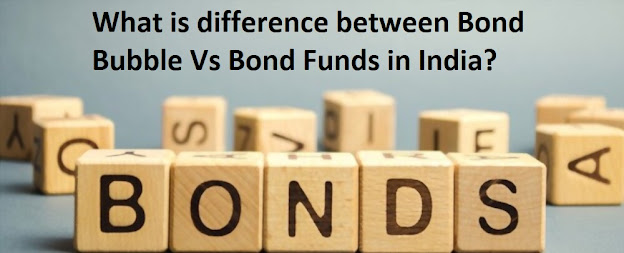Difference between Bond Bubble Vs Bond Funds in India?
If you are presently investing money in Bonds and invest in fixed income security or plan to invest money in bond funds you should understand what effect a bond bubble would have on your investment if the bubble bursts in 2013 or 2014.
What's a bond bubble, and which funds are most dangerous to invest money in?
All bonds investment (also called INCOME FUNDS) invest money for their investors in debt obligations called bonds (debt securities). It pass the interest income they earn to investors in the form of dividends, which are often automatically reinvested to buy bonds online in India. A bond bubble is like any other bubble (like a stock bubble) in the financial markets. When prices reach EXTREME levels that are not sustainable, you've got a bubble. When that bubble bursts prices fall like a rock.
Average investors have been investing money in bond funds for years while selling stock funds; and fund companies, as well as the Government bonds in india, have been investing money heavily in fixed income securities in india. This heavy buying activity sends bond prices up and Bonds interest rates down. And interest rates have hit EXTREME record lows, which means that bond prices are extremely high - hence, a bond bubble.
Why should you care about the investment in bonds? Remember, these fixed income securities trade in the open market after their original issue, just like stocks do, so they fluctuate in price. Investors invest money in them for the relatively high interest income they pay. When interest rates go down bonds go up in price because they pay an interest rate that is fixed, making existing bonds more attractive relative to other income producing alternatives. When rates go up, debt securities and bond investment that hold them go down in price (value).
In 2012 you could invest $1000 in the highest quality 30-yr bond and earn 3% a year, or $30 a year in interest income for the next 30 years. What would you be willing to pay for that same investment if you could earn 6% or $60 a year in a new issue of the same security in 2013, 2014 or beyond?
If you are presently investing money in a high-quality long term bond fund, the fund owns the fixed income securities investment in india. You own fund shares, and a very small part of a large investment portfolio. A bursting bond bubble means that bond prices fall off a cliff - resulting in higher interest rates and big losses for investors. The problem with long term funds is that they hold bonds that are locked into low interest rates for a long time (20 years or more). In July of 2012, the highest quality bonds in the world, which are the U.S. 30-year Treasury bond, fell to an interest rate yield of less than 2 ½%... having been as high as 14% in 1981!
That's why bond funds have been a good place to invest money, basically for more than 30 years. Interest rates have been falling. In 2013 and 2014 we're likely looking at the flip side and a bond bubble because rates can't get much lower, but could go up significantly. Few investors today have a handle on what happens when interest rates go up. The last time bond fund investors got rocked was between 1977 and 1981 when rates just about doubled. What happened to long term bond funds? They lost almost ½ of their value. Long term funds are the most dangerous to own in 2013, 2014 and beyond.
Bond funds that hold debt securities that on average mature in like 5, 6, or 7 years vs. 20 or more pay lower dividends; but are a much safer place to invest money to avoid heavy losses if the bond bubble bursts or at least deflates. Why? The securities they own, and the investor is investing money into, are in fixed income securities that have an interest rate that's only locked in for a few years vs. 20 years or more. Upon maturity (in 5, 6, or 7 years) the securities are redeemed, and owners (like fund companies) get their principal (like $1000) back and the security no longer exists (like a loan you pay off). The fund then simply replaces the security with another one to stay fully invested.
The bond bubble bursting could send your investment portfolio into a tailspin in 2013 or 2014 if you are holding bond funds that hold long term maturities. Remember, these funds have been good steady performers for years, even in the recent environment of lower and lower interest rates. The reason investing money here has been quite profitable for many investors is NOT because they have earned high interest rates and paid investors high dividends in recent years. Their dividends have been only relatively high compared to earning less than 1% at the bank.
Investing money in bonds funds has been profitable because lower interest rates have sent bond prices (and hence bond fund share prices) higher. But remember, these funds involve risk. If the interest rate trend reverses in 2013 or 2014 bond funds will lose money. If the bond bubble unravels severally and in a hurry, many bond fund investors will get hit hard. Take a look at the AVERAGE MATURITY of your bond funds. Look for funds with an average maturity closer to 5 to 7 years vs. 20 or more.


Comments
Post a Comment